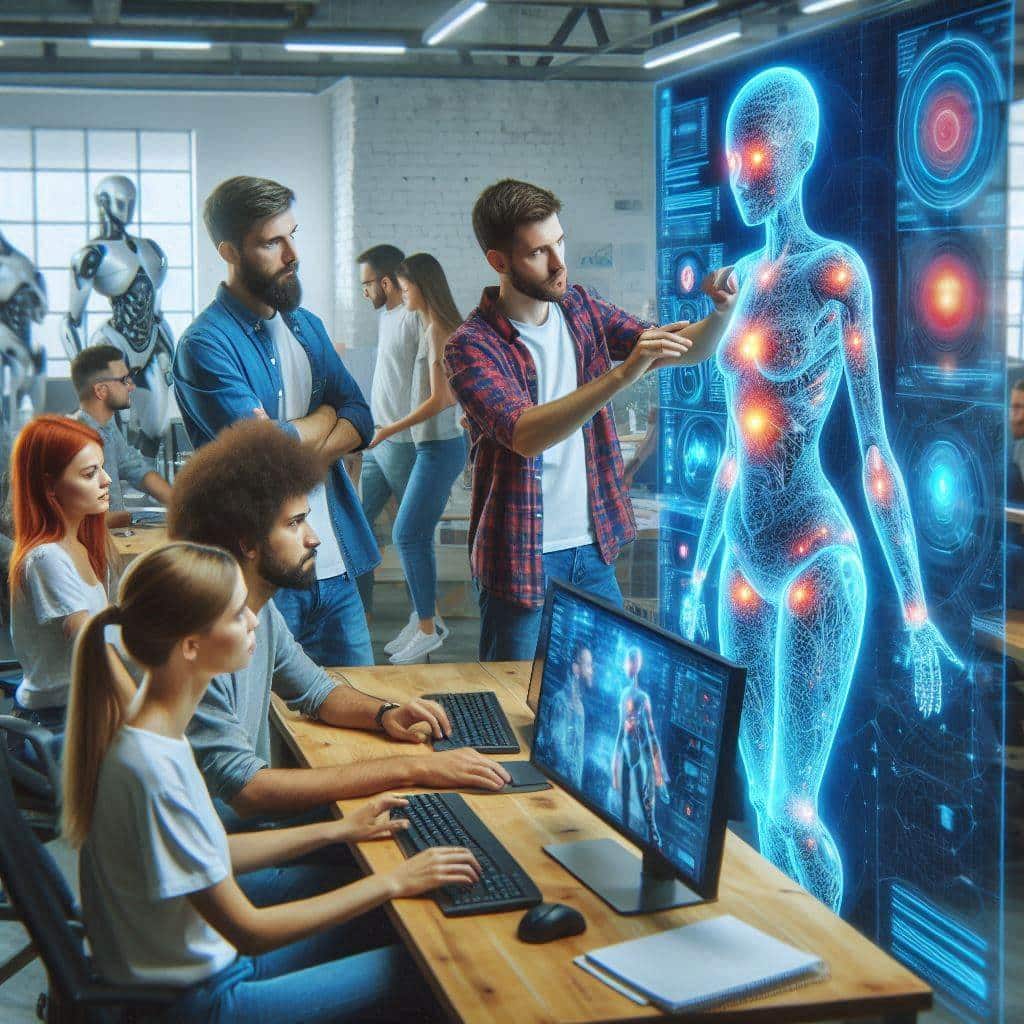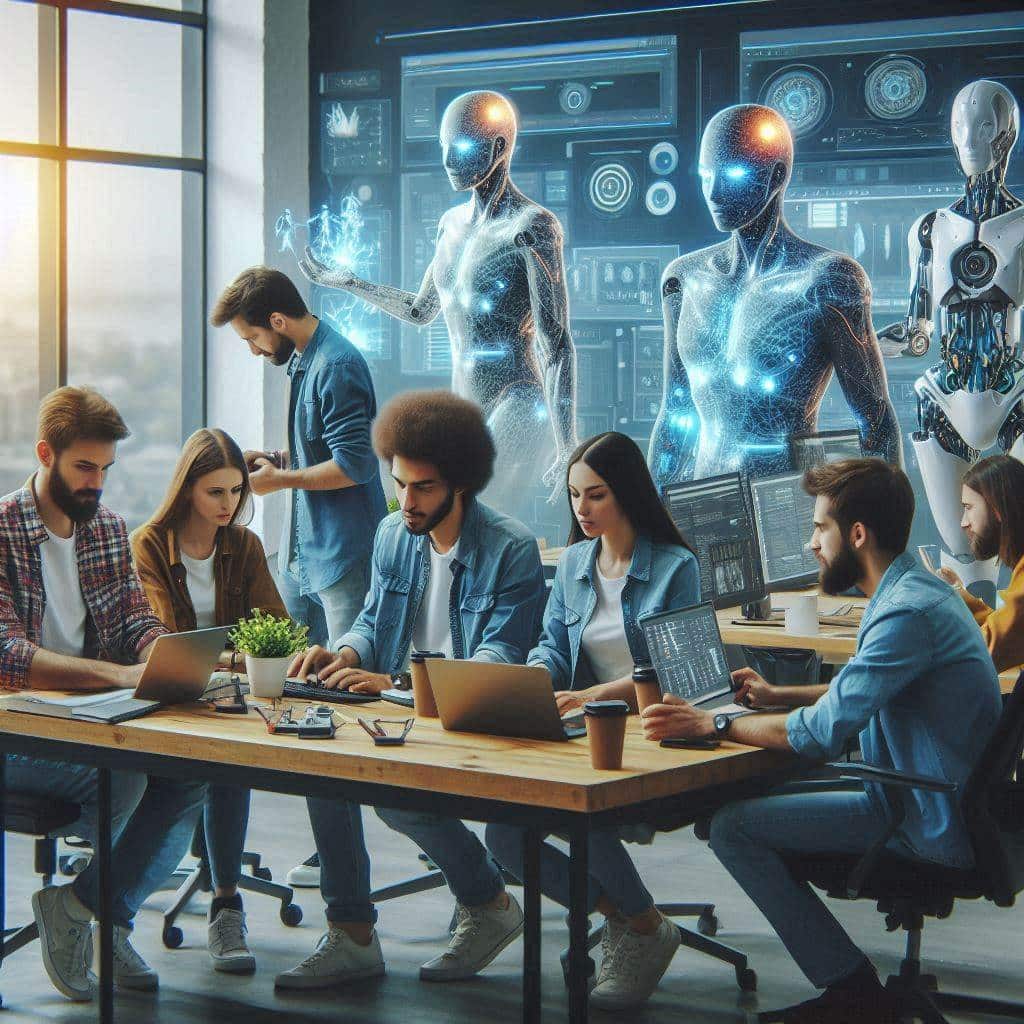Game development has come a long way from its early days of pixelated graphics and simplistic mechanics. Today, one of the most exciting advancements in game development is the use of artificial intelligence (AI) and machine learning (ML). These technologies are not just enhancing the visual and auditory aspects of games but are fundamentally transforming how games are played and experienced. From creating intelligent non-player characters (NPCs) to designing dynamic game environments, AI and machine learning are at the forefront of game innovation.
In this blog post, we’ll dive into how AI and machine learning are being utilized in game development, explore some of the game AI techniques used, and discuss real-world applications that demonstrate the power of these technologies.

Read more: The Impact of AI on Game Development: A New Era of Gaming(Opens in a new browser tab)
The Role of AI in Game Development
AI in game development refers to the creation of systems that can perform tasks which typically require human intelligence. This includes decision-making, learning, problem-solving, and adapting to new situations. In the context of games, AI is used to create more realistic and challenging NPCs, generate complex environments, and even assist in the development process itself.
Smarter NPCs
One of the primary uses of AI in games is to enhance the behavior of NPCs. Traditional game AI often relies on scripted behavior, where NPCs follow predefined patterns. While effective, this approach can lead to predictable and repetitive gameplay. AI and machine learning allow for more dynamic and realistic NPC behaviors.
Techniques for Creating Smarter NPCs:
- Finite State Machines (FSM): This is one of the oldest AI techniques used in games. FSMs enable NPCs to switch between different states (e.g., idle, patrol, attack) based on specific triggers.
- Behavior Trees: These provide a more flexible and scalable approach to defining NPC behavior. Behavior trees allow NPCs to make decisions based on a hierarchical structure of tasks and conditions.
- Utility AI: This method involves assigning a utility value to different actions an NPC can take, allowing them to choose the most appropriate action based on the current situation.
- Machine Learning: Techniques like reinforcement learning enable NPCs to learn from their actions and adapt their behavior over time. For example, an NPC could learn to improve its combat tactics based on player strategies.
Read more: Machine Learning in Game Development: Where Creativity Meets Algorithms(Opens in a new browser tab)
Dynamic Game Environments
Beyond NPCs, AI is also used to create dynamic and responsive game environments. These environments can change based on player actions, making each playthrough unique.
Techniques for Dynamic Environments:
- Procedural Content Generation (PCG): AI algorithms generate game content such as levels, maps, and quests. This can lead to virtually infinite variations in game environments, enhancing replayability.
- Adaptive Difficulty: AI adjusts the game’s difficulty in real-time based on the player’s performance. If a player is struggling, the game might become easier, and vice versa.
- Environmental Storytelling: AI can alter the game world in subtle ways to tell a story. For example, an AI system might change the environment to reflect the consequences of the player’s choices.
AI in Game Development Tools
AI is not just used within games but also in the tools developers use to create them. These AI-powered tools can streamline the development process, making it easier to design, test, and optimize games.
Examples of AI in Development Tools:
- Automated Testing: AI can automatically test games, identifying bugs and performance issues more efficiently than human testers.
- Level Design: AI can assist in level design by generating layouts that meet specific criteria, such as balance and flow.
- Content Creation: AI tools can help create game assets, including textures, models, and animations, saving time and resources for developers.
Machine Learning in Game Development
Machine learning, a subset of AI, involves training algorithms to learn from data and make predictions or decisions. In game development, machine learning can be used for various purposes, from enhancing NPC intelligence to personalizing the player experience.
Enhancing NPC Intelligence
Machine learning algorithms, particularly reinforcement learning, can be used to train NPCs to improve their behavior over time. By simulating thousands or millions of gameplay scenarios, NPCs can learn to adapt to different player strategies and become more challenging opponents.
Use Case: AlphaGo and AlphaStar
One of the most famous examples of machine learning in games is Google DeepMind’s AlphaGo, which defeated human world champions in the game of Go. Building on this success, DeepMind developed AlphaStar, which achieved similar success in the real-time strategy game StarCraft II. These achievements demonstrate the potential of machine learning to create highly intelligent game agents.
Read more: How AI is Revolutionizing Game Development(Opens in a new browser tab)
Personalizing Player Experience
Machine learning can also be used to analyze player data and personalize the game experience. By understanding player preferences and behaviors, games can adapt in real-time to provide a more engaging and tailored experience.
Techniques for Personalization:
- Player Profiling: Machine learning algorithms analyze player data to create profiles that describe their playstyle, preferences, and skill level.
- Dynamic Content: Games can use these profiles to dynamically adjust content, such as offering different quests, enemies, or rewards based on the player’s profile.
- Recommendation Systems: Similar to how streaming services recommend content, games can use machine learning to suggest in-game items, levels, or challenges that the player might enjoy.
Real-World Applications and Use Cases
To illustrate the impact of AI and machine learning in game development, let’s look at some real-world applications and use cases.

Example 1: Middle-earth: Shadow of Mordor
Nemesis System: This game features an advanced AI system called the Nemesis System, where NPCs remember interactions with the player and adapt their behavior accordingly. Enemies who survive encounters with the player can grow stronger, remember past fights, and hold grudges, leading to a dynamic and personalized gameplay experience.
Example 2: No Man’s Sky
Procedural Generation: No Man’s Sky uses AI-driven procedural generation to create an entire universe with billions of unique planets, each with its own ecosystems, landscapes, and life forms. This allows players to explore a vast and diverse game world that feels almost infinite.
Example 3: FIFA Series
AI Opponents: The FIFA series uses advanced AI to create realistic soccer simulations. The AI-controlled players can analyze the game in real-time, making strategic decisions that mimic real-life soccer tactics. Machine learning techniques help improve the AI’s performance by learning from thousands of real soccer matches.
Example 4: Left 4 Dead
AI Director: The AI Director in Left 4 Dead adjusts the game’s pacing and difficulty based on the players’ performance. It controls the timing and placement of enemies, items, and events to create a dynamic and engaging experience tailored to the players’ skill level.
Read more: Machine Learning: Unleashing the Power of Algorithms and Data(Opens in a new browser tab)
Future Trends in AI and Machine Learning in Games
The future of AI and machine learning in game development looks incredibly promising. Here are some trends to watch:
1. Advanced Procedural Generation
As AI algorithms become more sophisticated, we can expect even more advanced procedural generation techniques, creating highly detailed and varied game worlds that offer unique experiences for every player.
2. Deeper Personalization
Machine learning will continue to enhance personalization, offering more tailored experiences that adapt to players’ preferences and behaviors in real-time.
3. Improved NPC Interactions
NPCs will become even more intelligent and responsive, capable of holding complex conversations and exhibiting human-like behaviors.
4. AI-Driven Narrative Design
AI could play a significant role in narrative design, creating branching storylines that adapt to player choices and ensuring that every playthrough is unique and engaging.
Conclusion
AI and machine learning are revolutionizing game development, providing new tools and techniques that enhance gameplay and create more immersive experiences. From smarter NPCs and dynamic environments to personalized player experiences, these technologies are pushing the boundaries of what’s possible in games.
By understanding and harnessing the power of AI and machine learning, game developers can create richer, more engaging worlds that captivate players and keep them coming back for more. The future of game development is bright, and AI is at the heart of this exciting evolution.
Incorporating AI in game development opens up a world of possibilities, making games smarter, more dynamic, and infinitely more engaging. Whether you’re a game developer or an avid gamer, it’s fascinating to see how these technologies are shaping the future of gaming. So, dive into the world of AI in game development and explore the incredible potential it holds.



